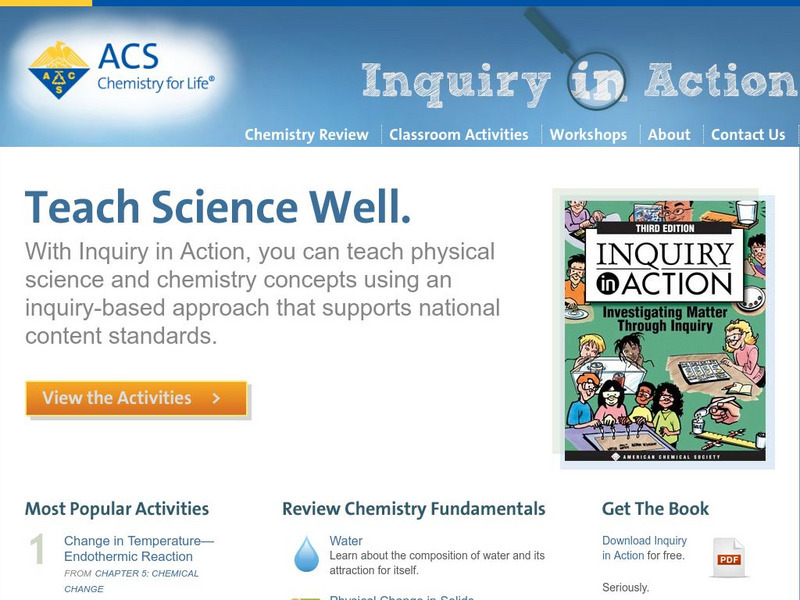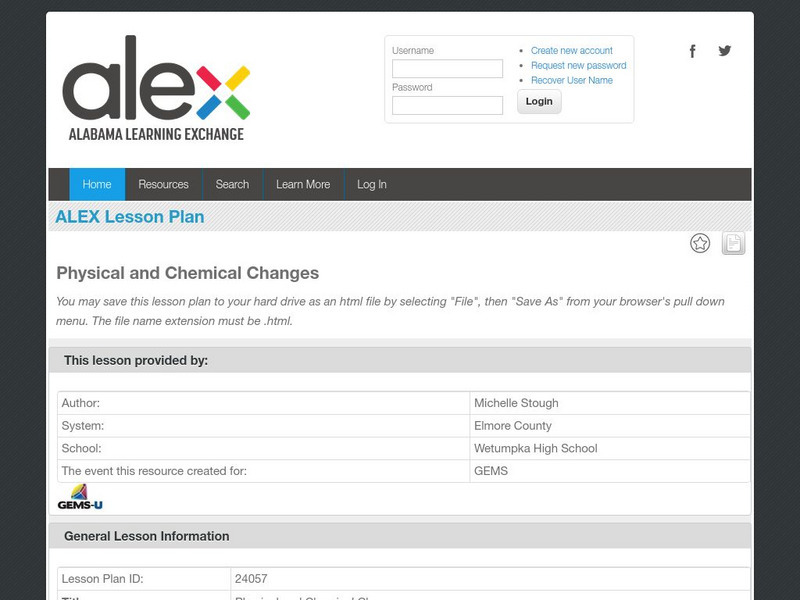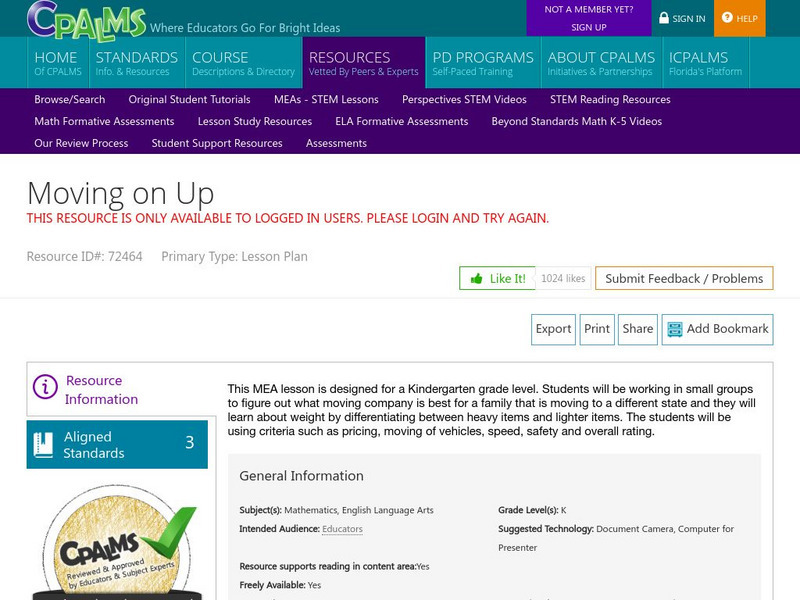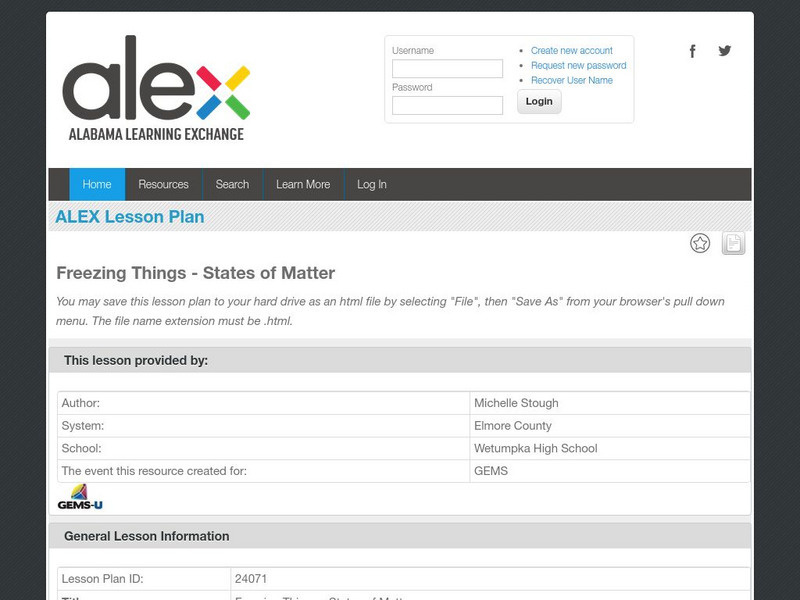Curated OER
The Quicker the Better? Food Processing
Sixth graders explore food processing. In this food processing lesson, 6th graders investigate the effects of processing foods on the food's nutritional value. Students examine a variety of healthy snack options.
Curated OER
Here's Looking at You
Students assess some common inherited traits which are easily observable and note their phenotype for the trait. Students compare their phenotypes to those of their parents and attempt to describe the pattern and manor of inheritance.
Curated OER
Symmetry: Theory, Reality and Art!
Students explore the concept of geometric symmetry. In this geometric symmetry lesson, students walk around their school and take pictures of objects that demonstrate symmetry. Students use Microsoft Paint to draw the lines of symmetry...
American Chemical Society
American Chemical Society: Inquiry in Action: Teach Science Well
Online textbook reviews fundamentals of chemistry and physical science via slideshow presentations, notes, and videos. Materials for classroom activities engage students in inquiry-based, hands-on investigations covering molecular...
American Chemical Society
American Chemical Society: Inquiry in Action: Teach Science Well
Online textbook reviews fundamentals of chemistry and physical science via slideshow presentations, notes, and videos. Materials for classroom activities engage students in inquiry-based, hands-on investigations covering molecular...
American Chemical Society
American Chemical Society: Science for Kids: Chemical and Physical Change
Engaging hands-on science lessons for grades 2-6 on chemical and physical changes.
Science Buddies
Science Buddies: A Day in the Life of Your Heart
Heart rates can be determined by the amount of physical activity your body is engaging in. The more physically active you are, the faster your heart beats. You can measure the rate your heart is beating by taking your pulse. This science...
Alabama Learning Exchange
Alex: Physical and Chemical Changes
The teacher will conduct the whoosh bottle demonstration to engage students. The class will then begin discussion of endothermic and exothermic physical and chemical changes. The students will then conduct the Science in Motion lab...
National Science Foundation
National Science Foundation: The Science of the Olympic Winter Games
A 16-part video series from the partnership of NBC and the National Science Foundation, on the "physics, biology, chemistry, and materials engineering behind the Olympic Winter Games." Exciting and engaging videos give new meaning to...
PBS
Pbs Learning Media: Bringing the Universe to America's Classroom: Collection
Engage K-12 students with phenomena and science practices using this collection of supplementary digital media resources created by GBH in collaboration with NASA. The resources align with key NGSS Earth, space, and physical science...
Utah Education Network
Uen: I'm So Bright! I Wear My Shades Indoors!
This lesson engages students in learning about light through multiple sources. Students will learn how light is produced, reflected, refracted, and separated. Students will communicate their findings through an independent project that...
Utah Education Network
Uen: Enlightening Explorations, Part Ii
This instructional activity engages students in learning about light. Studets will describe how light is produced, reflected, refracted, and separated.
Alabama Learning Exchange
Alex: Let's Get Physical! (Or Chemical Weathering)
This lesson helps students learn the differences between physical and chemical weathering. Students will complete various activities in which they identify and describe the type of weathering that is taking place.This lesson plan was...
CPALMS
Ice Cream Truck Favorites
[Free Registration/Login Required] During this MEA simulation, kindergarten students will determining the top three flavors of ice cream bars that an ice cream truck should serve. Students must work in cooperative groups as they work to...
CPALMS
Moving on Up
[Free Registration/Login Required] During this MEA simulation, kindergarten students will be preparing for a move to another state. Students must work in cooperative groups as they determine which moving company will be the best for...
US Geological Survey
U.s. Geological Survey: What's in My Soil? [Pdf]
Lesson plan engages students to separate, examine and identify the major components of soil to better understand how these components give soil its unique physical characteristics.
Other
Learners Edge: Play in the Classroom
Play is not more important than science, literacy, physics, or math - it IS science, literacy, physics, and math. It is the FOUNDATION for learning. This article touches on the research supporting the importance of incorporating play...
Alabama Learning Exchange
Alex: What's the Matter: A Sinker or Floater?
Students will explore matter that sinks or floats when submerged in water and that matter is categorized as either a sinker or a floater. Students will work actively in small, cooperative learning groups as well as gather in a whole...
Alabama Learning Exchange
Alex: Minerals
The students will gain information on the five characteristics of minerals. The information can be related to nonrenewable resources. This instructional activity should facilitate discussion on the difference between precious gems and...
Alabama Learning Exchange
Alex: What's the Matter: Concentration Game
What's the Matter? is a guided inquiry lesson on classification of matter, physical and chemical properties, and physical and chemical changes. There are two parts to this lesson: (a) concentration game for definitions and (b)...
Alabama Learning Exchange
Alex: Freezing Things: States of Matter
The class will go back over the Power Point presentation on chemical and physical properties. The teacher will then conduct numerous liquid nitrogen demos. This lesson is used early in the Chemistry course. The students love it. This...
Alabama Learning Exchange
Alex: Force and Motion
In this lesson, the young scholars will work across the curriculum using technology, business education, and mathematics. They will form a company and use the physics of force and motion to build a hovercraft. The students will use this...
Alabama Learning Exchange
Alex: Jump!!! An Exploration Into Parametric Equations
Students will use vectors and parametric equations to determine the velocity that they should jump out of the window of a burning building in order to land safely into the rescue net. They will work in small groups and utilize graphing...




















